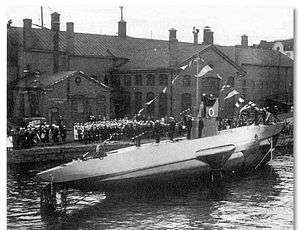Finnish submarine Saukko
 Saukko | |
| Class overview | |
|---|---|
| Builders: | Sandvikens shipyard, Helsinki |
| Operators: |
|
| In service: | 1930–1952 |
| In commission: | 16 December 1930 – 1947 |
| Completed: | 1 |
| Retired: | 1 |
| Preserved: | 0 |
| General characteristics | |
| Displacement: |
|
| Length: | 32.4 m (106 ft) |
| Beam: | 4.1 m (13 ft) |
| Draft: | 2.9 m (9.5 ft) |
| Propulsion: | 1 × Germaniawerft diesel, 200 hp (150 kW); 1 × electric motor 120 shp (89 kW). |
| Speed: |
|
| Range: |
|
| Complement: | 15 |
| Armament: |
|
Saukko (Pu110) was a small submarine that served in the Finnish Navy during the Second World War. It was designed not to exceed 100 tonnes, as it was planned for use in Lake Ladoga, and according to the 1920 Treaty of Tartu, no nation was allowed to use naval ships of more than 100 tonnes on the lake (When completed, Saukko weighed somewhat more than this). The submarine could be divided into separate sections and transported by rail. The conning tower could be lifted off entirely. The engines were in the aft section and the batteries in the forward section. The name "Saukko" means European otter.
The construction of Saukko
The construction of Saukko began in 1928 at Sandvikens shipyard in Helsinki. The design was based on German drawings for the submarine Pu110 ("smaller, quickly assemblable submarine prototype"). Launched on 2 July 1930, Saukko was declared ready for service on 16 December 1930. At that time it was the world's smallest submarine, officially weighing only 99 tonnes. Saukkos crew consisted of 15 men. The outer hull was designed for icy conditions.
Operational history
Original plans called for Saukko to be brought to the town of Lahdenpohja on Lake Ladoga via rail, but this was never implemented. During the Winter War (1939–1940) and the Continuation War (1941–1944), the submarine operated in the Gulf of Finland.
Winter War
Saukko, accompanied by several motor torpedo boats, was towed by the gunboat Karjala to Koivisto on 7 December 1939. Since hostilities had started before the Finnish Navy had not had a chance to lay defensive minefields outside their coastal forts, it was hoped that Saukko might be able to accomplish that task. A Leningrad class destroyer and five other Soviet destroyers reached the area on 8 December, and began to shell Finnish positions. The slow Saukko was unable to engage the Soviet destroyer group.[1] On the following day ice prevented Finnish boats from sortieing against the bombarding Soviet ships, and when the ice was finally broken, half of the air valves on Saukko were frozen, which nearly caused the boat to capsize when it tried to submerge to lay a minefield. After these failures the Finnish boats were withdrawn from the area.[1]
Continuation War
On 3 July 1941 Saukko was patrolling off the island of Sommers when she sighted a couple of patrol vessels by the pier. The submarine fired a torpedo but was forced to withdraw, without being able to observe results, by harassing Soviet patrol boats.[2]
References
External links
| Wikimedia Commons has media related to Saukko (submarine, 1930). |